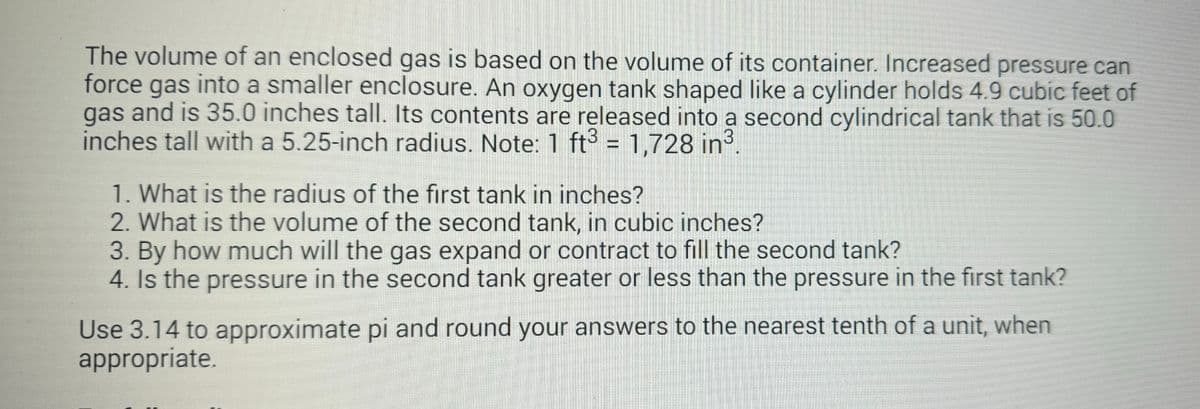The volume of an enclosed gas is based on the volume of its container. Increased pressure can force gas into a smaller enclosure. An oxygen tank shaped like a cylinder holds 4.9 cubic feet of gas and is 35.0 inches tall. Its contents are released into a second cylindrical tank that is 50.0 inches tall with a 5.25-inch radius. Note: 1 ft3 = 1,728 in³. 1. What is the radius of the first tank in inches? 2. What is the volume of the second tank, in cubic inches? 3. By how much will the gas expand or contract to fill the second tank? 4. Is the pressure in the second tank greater or less than the pressure in the first tank? Use 3.14 to approximate pi and round your answers to the nearest tenth of a unit, when appropriate.
The volume of an enclosed gas is based on the volume of its container. Increased pressure can force gas into a smaller enclosure. An oxygen tank shaped like a cylinder holds 4.9 cubic feet of gas and is 35.0 inches tall. Its contents are released into a second cylindrical tank that is 50.0 inches tall with a 5.25-inch radius. Note: 1 ft3 = 1,728 in³. 1. What is the radius of the first tank in inches? 2. What is the volume of the second tank, in cubic inches? 3. By how much will the gas expand or contract to fill the second tank? 4. Is the pressure in the second tank greater or less than the pressure in the first tank? Use 3.14 to approximate pi and round your answers to the nearest tenth of a unit, when appropriate.
Mathematics For Machine Technology
8th Edition
ISBN:9781337798310
Author:Peterson, John.
Publisher:Peterson, John.
Chapter63: Volumes Of Pyramids And Cones
Section: Chapter Questions
Problem 25A
Related questions
Question

Transcribed Image Text:The volume of an enclosed gas is based on the volume of its container. Increased pressure can
force gas into a smaller enclosure. An oxygen tank shaped like a cylinder holds 4.9 cubic feet of
gas and is 35.0 inches tall. Its contents are released into a second cylindrical tank that is 50.0
inches tall with a 5.25-inch radius. Note: 1 ft3 = 1,728 in³.
1. What is the radius of the first tank in inches?
2. What is the volume of the second tank, in cubic inches?
3. By how much will the gas expand or contract to fill the second tank?
4. Is the pressure in the second tank greater or less than the pressure in the first tank?
Use 3.14 to approximate pi and round your answers to the nearest tenth of a unit, when
appropriate.
Expert Solution
This question has been solved!
Explore an expertly crafted, step-by-step solution for a thorough understanding of key concepts.
This is a popular solution!
Trending now
This is a popular solution!
Step by step
Solved in 1 steps

Recommended textbooks for you

Mathematics For Machine Technology
Advanced Math
ISBN:
9781337798310
Author:
Peterson, John.
Publisher:
Cengage Learning,

Elementary Geometry For College Students, 7e
Geometry
ISBN:
9781337614085
Author:
Alexander, Daniel C.; Koeberlein, Geralyn M.
Publisher:
Cengage,

Elementary Geometry for College Students
Geometry
ISBN:
9781285195698
Author:
Daniel C. Alexander, Geralyn M. Koeberlein
Publisher:
Cengage Learning

Mathematics For Machine Technology
Advanced Math
ISBN:
9781337798310
Author:
Peterson, John.
Publisher:
Cengage Learning,

Elementary Geometry For College Students, 7e
Geometry
ISBN:
9781337614085
Author:
Alexander, Daniel C.; Koeberlein, Geralyn M.
Publisher:
Cengage,

Elementary Geometry for College Students
Geometry
ISBN:
9781285195698
Author:
Daniel C. Alexander, Geralyn M. Koeberlein
Publisher:
Cengage Learning

Glencoe Algebra 1, Student Edition, 9780079039897…
Algebra
ISBN:
9780079039897
Author:
Carter
Publisher:
McGraw Hill

Holt Mcdougal Larson Pre-algebra: Student Edition…
Algebra
ISBN:
9780547587776
Author:
HOLT MCDOUGAL
Publisher:
HOLT MCDOUGAL